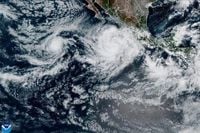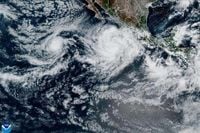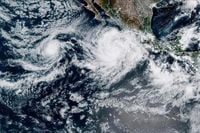Western Mexico and the surrounding Pacific region have been battered by intense weather as Hurricane Priscilla strengthened rapidly, bringing heavy rain, powerful winds, and dangerous surf to coastal communities and the Baja California peninsula. The storm, which began as Tropical Storm Priscilla in the eastern Pacific off Mexico on October 5, 2025, quickly gained strength, becoming a major concern for residents and authorities alike, according to the Associated Press and multiple advisories from the U.S. National Hurricane Center in Miami.
By Monday, October 6, 2025, Priscilla was already lashing western Mexico with maximum sustained winds of 85 mph (137 kph), positioned about 245 miles (395 kilometers) south-southwest of Cabo Corrientes. The hurricane was moving north-northwest at a slow pace of 5 mph (8 kph), but the impact was immediate: heavy rainfall and gusty winds swept through parts of southwestern Mexico, with ocean swells causing dangerous surf and rip currents along the coasts of southwestern and western Mexico as well as southern Baja California.
Forecasters warned of significant rainfall totals, with up to 6 inches (15 centimeters) possible in some areas, particularly in the states of Guerrero, Michoacán, Colima, and Jalisco. This raised the specter of flash flooding—a risk that would only intensify as the storm grew stronger. The National Hurricane Center issued a tropical storm watch for the coast of southwestern Mexico, stretching from Punta San Telmo to Punta Mita, signaling that tropical storm conditions were expected between Sunday and Monday.
As Priscilla continued its journey northwestward, the storm intensified. By early Tuesday, October 7, 2025, Hurricane Priscilla had strengthened to a Category 2 hurricane, with maximum sustained winds reaching 100 mph (161 kph). The storm's center was located about 260 miles (418 kilometers) west-southwest of Cabo Corrientes, and approximately 230 miles (370 kilometers) south of the southern tip of Baja California, moving at a slightly faster pace of 10 mph (16 kph), as reported by the Associated Press and the National Hurricane Center.
The government of Baja California Sur responded swiftly to the growing threat. On the night of October 6, officials announced the cancellation of classes at all educational centers in Los Cabos and La Paz starting Tuesday, October 7, as a preventive measure. In addition, a dozen shelters were established in Los Cabos for residents living in areas at risk from the hurricane's effects. These actions were aimed at ensuring the safety of the local population, especially those most vulnerable to flooding and wind damage.
Parts of southwestern Mexico, particularly Michoacán and Colima, were forecast to receive up to 4 inches (10 centimeters) of rain from Priscilla's outer bands through Wednesday, October 8, with the risk of flash flooding remaining high. The storm's influence extended beyond rainfall: swells generated by Priscilla were already reaching the Mexican coast, creating life-threatening surf and rip currents. The National Weather Service cautioned residents and visitors that these conditions could be perilous, urging them to stay away from affected beaches and heed all local warnings.
As Priscilla spun off the Pacific coast, forecasters anticipated the hurricane could reach major hurricane status—defined as Category 3 or higher, with wind speeds of at least 111 mph (180 kph)—later on Tuesday. However, the National Hurricane Center also predicted that weakening would begin by Wednesday, October 8. The storm's projected path kept it offshore, but its outer bands were still expected to bring hazardous conditions to land.
Meanwhile, another weather system in the Pacific, Tropical Storm Octave, was also under observation. Octave had briefly achieved hurricane status on October 5, but by early October 6, it had been downgraded back to a tropical storm, with maximum sustained winds of 70 mph (113 kph). The storm was located about 840 miles (1,350 kilometers) southwest of the southern tip of Baja California and was moving east-southeast at a modest 7 mph (11 kph). Importantly, Octave posed no threat to land; there were no coastal watches or warnings in effect, and forecasters expected the storm to continue weakening and dissipate within a few days.
The Atlantic basin was also making headlines as Tropical Storm Jerry formed on Tuesday, October 7, 2025. According to the National Hurricane Center, Jerry was about 1,315 miles (2,120 kilometers) east-southeast of the northern Leeward Islands, moving west at 24 mph (39 kph) with maximum sustained winds of 45 mph (75 kph). Forecasters anticipated that Jerry would strengthen into a hurricane in the coming days, and swells generated by the storm were expected to reach the Leeward Islands by Thursday. Although Jerry was still far from land, its rapid development added another layer of concern for meteorologists tracking a busy storm season.
Back in Mexico, the response to Hurricane Priscilla underscored the importance of preparedness and swift government action in the face of natural disasters. The cancellation of classes and the establishment of shelters in Los Cabos were clear signals that authorities were taking the threat seriously. The National Hurricane Center continued to monitor the situation closely, issuing regular updates and advisories to keep the public informed.
For residents along the Pacific coast of Mexico and the Baja California peninsula, the past few days have been a stark reminder of the region's vulnerability to powerful storms. The combination of heavy rain, strong winds, and dangerous surf can lead to flooding, property damage, and, in the worst cases, loss of life. The flash flooding risk in Michoacán and Colima, in particular, remained a major concern as Priscilla's outer bands continued to dump rain on already saturated ground.
As of Tuesday, the focus remained on monitoring Priscilla's progress and ensuring that all necessary precautions were in place. With the storm expected to weaken after reaching its peak intensity, there was cautious optimism that the worst might soon be over. Still, the experience served as a powerful reminder of the unpredictable and sometimes devastating nature of hurricane season in the eastern Pacific and Atlantic basins.
While Tropical Storm Octave faded into the background and Jerry began its journey across the Atlantic, all eyes stayed fixed on Priscilla as it churned off Mexico's coast—an ever-present force of nature demanding respect and vigilance from all those in its path.


